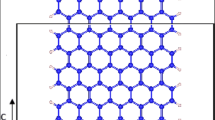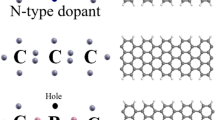Abstract
We present a system study on the electronic structure and optical property of boron doped semiconducting graphene nanoribbons using the density functional theory. Energy band structure, density of states, deformation density, Mulliken popular and optical spectra are considered to show the special electronic structure of boron doped semiconducting graphene nanoribbons. The C-B bond form is discussed in detail. From our analysis it is concluded that the Fermi energy of boron doped semiconducting graphene nanoribbons gets lower than that of intrinsic semiconducting graphene nanoribbons. Our results also show that the boron doped semiconducting graphene nanoribbons behave as p-type semiconducting and that the absorption coefficient of boron doped armchair graphene nanoribbons is generally enhanced between 2.0 eV and 3.3 eV. Therefore, our results have a great significance in developing nano-material for fabricating the nano-photovoltaic devices.
Similar content being viewed by others
References
Wang X, Zhi L J, Müllen K. Transparent, conductive graphene electrodes for dye-sensitized solar cells. Nano Lett, 2008, 8: 323–327
Geim K. Graphene: Status and prospects. Science, 2009, 324: 1530–1534
Novoselov K S, Geim A K, Morozov S V, et al. Two-dimensional gas of massless Dirac fermions in graphene. Nature, 2005, 438: 197–200
Lu G H, Ocola L E, Chen J H. Gas detection using low-temperature reduced graphene oxide sheets. Appl Phys Lett, 2009, 94: 083111
Li X M, Zhu H W, Wang K L, et al. Graphene-on-silicon Schottky junction solar cells. Adv Mater, 2010, 22: 2743–2748.
Novoselov K S, Geim A K, Morozov S V, et al. Electric field effect in atomically thin carbon films. Science, 2004, 306: 666–669.
Peres N M R, Castro Neto A H, Guinea F. Conductance quantization in mesoscopic graphene. Phys Rev B, 2006, 73: 195411
Gunlycke D, Lawler H M, White C T. Room-temperature ballistic transport in narrow graphene strips. Phys Rev B, 2007, 75: 085418
Nakada K, Fujita M. Edge state in graphene ribbons: Nanometer size effect and edge shape dependence. Phys Rev B, 1996, 54: 17954–17961
Motohiko E. Peculiar width dependence of the electronic properties of carbon nanoribbons. Phys Rev B, 2006, 73: 045432
Gabor N M, Zhong Z H, Bosnick K, et al. Extremely efficient multiple electron-hole pair generation in carbon nanotube photodiodes. Science, 2009, 325: 1367–1371
Way B M, Dahn J R. Preparation and characterization of BxC1−x thin films with the graphite structure. Phys Rev B, 1992, 46: 1697–1702
Garcia L E, Baltazar S E, Romero A H, et al. Influence of S and P doping in a graphene sheet. J Comput Theor Nanosci, 2008, 5: 1–9
Pontes R B, Fazzio A, Dalpian G M. Barrier-free substitutional doping of graphene sheets with boron atoms: Ab initio calculations. Phys Rev B, 2009, 79: 033412
Biel B, Blase X, Triozon F, et al. Anomalous doping effects on charge transport in graphene nanoribbons. Phys Rev B, 2009, 102: 096803
Hsu H, Reichl L E. Selection rule for the optical absorption of graphene nanoribbons. Phys Rev B, 2007, 76: 045418
Capelle K. A bird’s-eye view of density-functional theory. J Phys, 2006, 36: 1318–1343
Perdew J P, Burke K, Ernzerhof M. Generalized gradient approximation made simple. Phys Rev Lett, 1996, 77: 3865–3868
Troullier N, Martins J L. Efficient pseudopotentials for plane-wave calculations. Phys Rev B, 1991, 43: 1993–2006
Kleinman L, Bylander D M. Efficacious form for model pseudopotentials. Phys Rev Lett, 1982, 48: 1425–1428
Ordejón P, Artacho E, Soler J M. Self-consistent order-N density-functional calculations for very large systems. Phys Rev B, 1996, 53: R10441–10443
Soler J M, Artacho E, Gale J D, et al. The SIESTA method for ab initio order-N materials simulation. J Phys-Condes Matter, 2002, 14: 2745–2779
Artacho E, Sánchez-Portal D, Ordejón P, et al. Linear-scaling ab-initio calculations for large and complex systems. Phys Status Solidi B-Basic Solid State Phys, 1999, 215: 809–817
Monkhorst H J, Pack J D. Special points for Brillouin-zone integrations. Phys Rev B, 1976, 13: 5188–5192
Han M Y, Özyilmaz B, Zhang Y, et al. Energy band-gap engineering of graphene nanoribbons. Phys Rev Lett, 2007, 98: 206805
Barone V, Hod O, Scuseria G E. Electronic structure and stability of semiconducting graphene nanoribbons. Nano Lett, 2006, 6: 2748–2754
Chen A Q, Shao Q Y, Li Z. Special electronic structures and quantum conduction of B/P co-doping carbon nanotubes under electric field using the first principle. J Nanopart Res, 2011, 13: 2275–2283
Panchakarla L S, Subrahmanyam K S, Saha S K, et al. Synthesis, structure, and properties of boron- and nitrogen-doped graphene. Adv Mater, 2009, 21: 4726–4730
Economou E N. Green’s Functions in Quantum Physics. Berlin: Springer, 1983
Author information
Authors and Affiliations
Corresponding author
Rights and permissions
About this article
Cite this article
Chen, A., Shao, Q., Wang, L. et al. Electronic structure and optical property of boron doped semiconducting graphene nanoribbons. Sci. China Phys. Mech. Astron. 54, 1438–1442 (2011). https://doi.org/10.1007/s11433-011-4408-8
Received:
Accepted:
Published:
Issue Date:
DOI: https://doi.org/10.1007/s11433-011-4408-8




